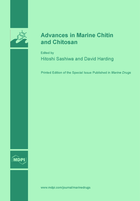Advances in Marine Chitin and Chitosan
A special issue of Marine Drugs (ISSN 1660-3397).
Deadline for manuscript submissions: closed (30 September 2014) | Viewed by 251034
Special Issue Editors
Interests: hydrogels and other biopolymers
Special Issues, Collections and Topics in MDPI journals
Interests: chemical modification of chitin and chitosan and their biomedical applications; biodegradable polymer; bio-based polymer
Special Issues, Collections and Topics in MDPI journals
Special Issue Information
Dear Colleagues,
The now considerable research history on chitin started in the 1970s. Since the 1980s, chitin research has progressed significantly over several stages in both fundamental and industrial fields. However, current overviews in recent publications involving chitin and chitosan research advances appear lacking. With the opening of this Special Issue, Advances in Marine Chitin and Chitosan in Marine Drugs, we plan to produce a strong, very exciting issue that will encompass breakthroughs in high value, scientific and industrial chitin and chitosan research.
We look forward very much to your input.
Dr. Hitoshi Sashiwa,
Prof. Dr. David Harding,
Guest Editors
Manuscript Submission Information
Manuscripts should be submitted online at www.mdpi.com by registering and logging in to this website. Once you are registered, click here to go to the submission form. Manuscripts can be submitted until the deadline. All submissions that pass pre-check are peer-reviewed. Accepted papers will be published continuously in the journal (as soon as accepted) and will be listed together on the special issue website. Research articles, review articles as well as short communications are invited. For planned papers, a title and short abstract (about 100 words) can be sent to the Editorial Office for announcement on this website.
Submitted manuscripts should not have been published previously, nor be under consideration for publication elsewhere (except conference proceedings papers). All manuscripts are thoroughly refereed through a single-blind peer-review process. A guide for authors and other relevant information for submission of manuscripts is available on the Instructions for Authors page. Marine Drugs is an international peer-reviewed open access monthly journal published by MDPI.
Please visit the Instructions for Authors page before submitting a manuscript. The Article Processing Charge (APC) for publication in this open access journal is 2900 CHF (Swiss Francs). Submitted papers should be well formatted and use good English. Authors may use MDPI's English editing service prior to publication or during author revisions.
Keywords
- chitin
- chitosan
- chito-oligosaccharide
- glucosamine
- N-acetyl-D-glucosamine
- chemical modification
- controlled drug delivery
- hydrogels
Related Special Issues
- Advances in Marine Chitin and Chitosan II, 2017 in Marine Drugs (25 articles)
- Application of Marine Chitin and Chitosan in Marine Drugs (13 articles)
- Marine Chitin 2021 in Marine Drugs (2 articles)
- Marine Chitin in Marine Drugs (8 articles)
- Marine Biodegradable Polymers in Marine Drugs (2 articles)
- Collagen and Chitin from Marine Resources and Their Interdisciplinary Applications in Marine Drugs (13 articles)








